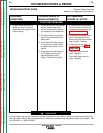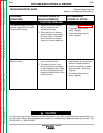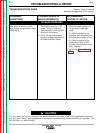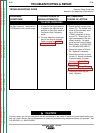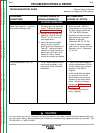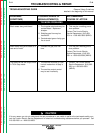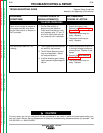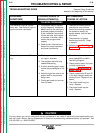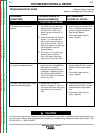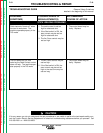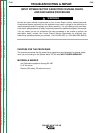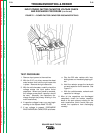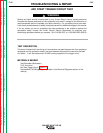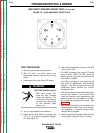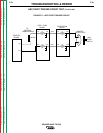
Return to Section TOC Return to Section TOC Return to Section TOC Return to Section TOC
Return to Master TOC Return to Master TOC Return to Master TOC Return to Master TOC
TROUBLESHOOTING & REPAIR
F-17 F-17
SQUARE WAVE TIG 355
TROUBLESHOOTING GUIDE Observe Safety Guidelines
detailed in the beginning of this manual.
CAUTION
If for any reason you do not understand the test procedures or are unable to perform the test/repairs safely, con-
tact the Lincoln Electric Service Department for electrical troubleshooting assistance before you proceed. Call
216-383-2531 or 1-800-833-9353.
PROBLEMS
(SYMPTOMS)
POSSIBLE AREAS OF
MISADJUSTMENT(S)
RECOMMENDED
COURSE OF ACTION
FUNCTION PROBLEMS
The Pulsar does not seem to
operate.
1. If the Start controls are used,
pulsing does not begin until
the end of the “start” time,
which can be as much as 10
seconds.
2. Check the Pulses Per Second
control. If it is set near mini-
mum, each pulse may be as
long as ten seconds. Set all
three of the pulse controls near
the midpoints to see the
pulser’s effects.
3. The Pulse % On control may
be set at either extreme. If
that is the case, the pulses
may be too short to be seen.
1. Check the Pulse controls (R18,
R19 and R20) for correct resis-
tance and proper operation.
See Wiring Diagram.
2. The control board may be
faulty. Replace.
The Spot Timer does not last as
long as the nameplate setting.
1. When in the 2-Step trigger
mode, be sure to keep the Arc
Start switch or Amptrol
pressed until the spot time is
completed. Releasing the Arc
Start switch before the Spot
Timer has timed out will cause
the arc to go out.
1. Check the Spot Timer control
potentiometer (R16) for correct
resistance and proper opera-
tion.
2. The control board may be
faulty. Replace.
The Spot Timer lasts much longer
than the nameplate setting.
1. Make sure the Crater Fill
switch is turned off. If it is on,
the actual weld time will be the
spot time plus the crater fill
time.
1. Check the Spot Timer control
potentiometer (R16) for correct
resistance and proper opera-
tion.
2. The control board may be
faulty. Replace.



